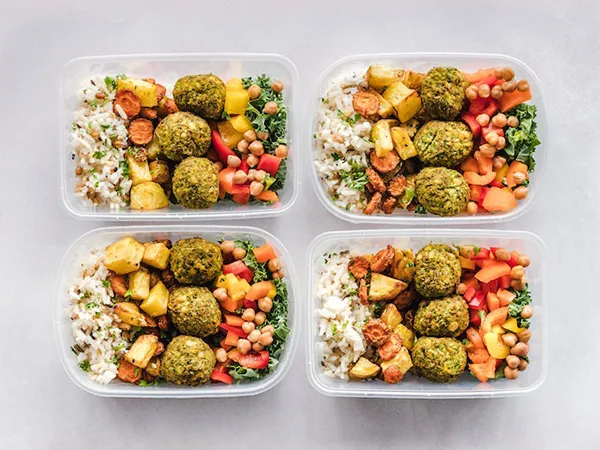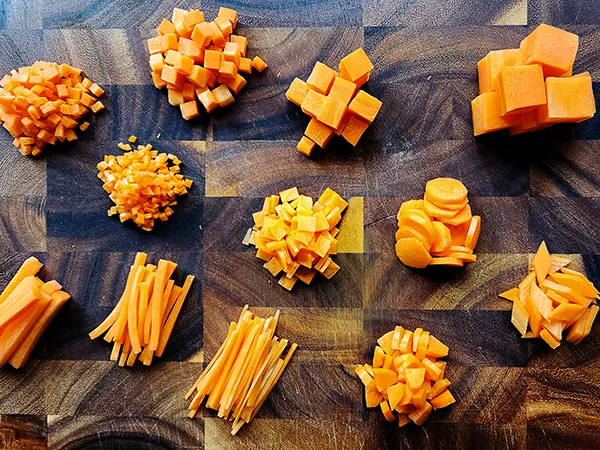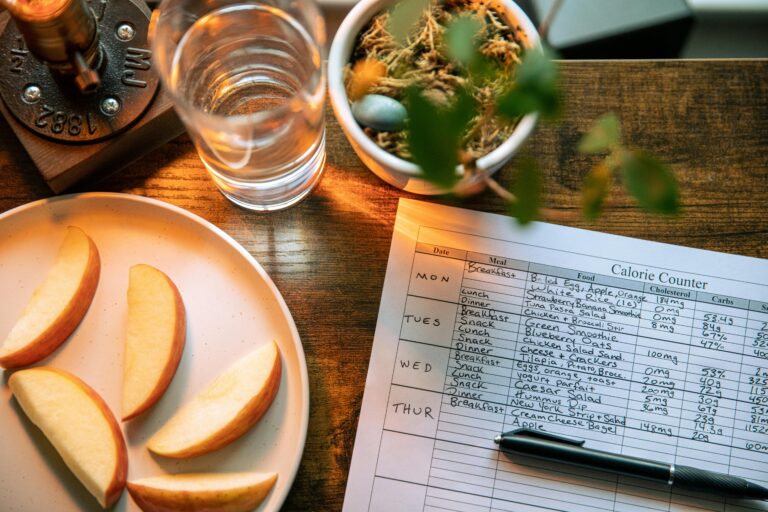Meal Planning for Beginners: 7 Easy Steps To Start A Healthy Habit
Hey friends who want to get meal planning! I’m so pumped to share my simple beginner’s guide to meal planning with you.
As a nutrition buff who loves planning my weekly menus, let me tell you – meal planning is a total game-changer for eating healthier!
Here’s the deal: Meal planning saves us time and money, reduces food waste, maintains our weight, and helps us eat better. It’s a win all around!
Whether you’re completely new to planning weekly menus or need a refresher, this guide is for you. Successful meal planning requires a bit of thinking ahead of time and you will need a grocery budget, but fear not! I’ll walk you through my easy process for choosing recipes, prepping grocery lists, and scheduling your meals. Also, I will be sharing simple recipes to kick-start your healthy eating.
Not convinced? Check it out then!
Why should I consider meal planning?

I know what you’re thinking – meal planning sounds like a lot of work and very time-consuming. But hear me out! There are so many awesome reasons to give it a try:
First up, planning your meals saves us crazy amounts of time and money. No more wasting hours figuring out what to eat each night or ordering expensive fast food when we’re feeling lazy. Meal planning lets us whip up fast, healthy homecooked meals instead!
Plus, having a weekly menu plan keeps us on track with healthier eating habits. We can plan balanced nutritious meals and have the ingredients ready to go. No more hanger pangs leading to poor food choices!
Meal planning also reduces food waste. Since we only buy what we need for planned recipes, less food ends up going bad in the fridge or pantry. A shopping list also will save you money since it will be easier to resist any impulse purchases. A win for our wallets and the planet!
And don’t forget – variety! When we take time to plan, our meals are more exciting and diverse. No more boring repeated dinners or canned beans for lunch. Meal planning brings new flavors to the table every week!
So are you on board with meal planning yet? A little upfront time will save us hours down the road, save money, keep us on track with nutrition, reduce waste, and infuse variety into our meals.
I’m in – how about you? Let’s do this!
Meal Planning for Beginners: Meal Prep Step-by-Step
When it comes to meal planning, there are a few different approaches from detailed daily plans to broader weekly recipes and everything in between.
As a beginner, the most accessible approach to meal planning would be to keep it simple!
I would start just making a simple lunch and dinner for the next few days. Pick 2 flexible recipes each week that can be repurposed into simple meals. Like lentil salad for lunch and sweet potatoes and salmon for dinner. This prevents decision fatigue and shopping multiple times a week.
Plan meals with this simple, stress-free approach, and eat fresh food every day.
Here are the steps to start creating your meal plans:
Step 1. Choose Your Meal Prep Day/Time
Cooking can be time-consuming especially if you are a beginner. So dedicate a few hours on a weekend day or weekday evening when you can focus. I find Sunday afternoons or Monday nights work best to get ready for the week ahead.
Step 2. Review Your Calendar and Take Inventory
Identify busy days or days when you will certainly eat out or any special occasions. Mark them down to understand how many meals you need to cook ahead.
Check the fridge to see what needs to be used up soon like fresh produce, dairy, and meat. Check your pantry for basic ingredients such as whole grains or dried beans and note the number of times I bought rice when I had it.
Step 3. Brainstorm Meal Ideas
Plan meals mindfully and include healthy foods such as whole grains, fresh vegetables, high-quality protein, and healthy fats such as avocados, nuts, and seeds.
Step 4. Make Your Grocery List
For a beginner try to keep it simple and shop for the next few days, when you get a hang of it you can try and compile a list for the whole week. Make a grocery list of all needed ingredients for planned recipes plus essentials like eggs, greek yogurt, and snacks.
Group ingredients by type/category to save time and money while shopping.
Step 5. Shop for Groceries
Shop on your designated meal prep day for maximum freshness. Grocery stores usually put the things they want to sell the most in front of our eyes. That’s why the grocery list is your friend! Stick to your list and stay away from convenience foods such as frozen pizza.
Opt for fresh ingredients over pre-prepped, frozen, and canned when possible. Buy large containers of foods with long shelf life like olive oil, dried beans, grains, dried fruit, flour, nuts, and seeds. With ordering online grocery shopping has never been easier, so I sometimes opt for that, yet mostly I try to buy my produce locally.
Step 6. Prep Ingredients
Meal prepping sounds more intimidating than it is. With a few of my hacks, you will be prepping meals ahead like a pro.
Beginners tips:
- Clear counters and give them a wipe
- Prep equipment like cutting boards, knives, peelers, and colander.
- Get your pan of water boiling and your oven hot
- Prep produce first like washing and peeling vegetables
- Now you are ready to start cooking meals
- Batch cook everything you need for recipes
If you want to enhance your skills and learn to cook like a chef be sure to check out my post. I also have a comprehensive guide on how to cook vegetables.
Step 7. Portion Out Meals and Snacks
Label containers by meal and day. I usually use stainless steel containers, but glassware and BPA-free plastic are as good. Portion grab-and-go snacks like carrots and cucumbers, hummus, and Greek yogurt. Position early week meals up front in the fridge.
That is it! That’s your road to nourishing meals every day. I hope that I encouraged you to start meal planning right away.
Sample Meal Prep Recipes
Alright, let’s talk about some deliciously healthy recipes to meal plan!
Starting the day off right, how about a protein-packed chia seed Greek yogurt to fuel your morning? It’s a simple, yummy way to incorporate fiber and protein.
Come lunchtime, a quick snack satisfying lentil salad bowl hits the spot. With protein-rich lentils, crunchy veggies, tangy dressing, and a pop of sweetness from dried fruits. It is so easy and convenient that it should be on all meal plans.
For dinner, bake up some flaky salmon fillets with broccoli for a hearty but healthy meal. Round it out with some brown rice, quinoa, or sweet potato and you’ve got balanced nutrition in one easy dish.
Meal planning gets so much easier when you have nutritious, delicious options to choose from!
Key considerations to successfully meal plan as a beginner
Make Time for Planning

Schedule meal planning into your routine. Set reminders on your calendar to choose recipes, grocery shop, and prep. Devote at least 1 hour on your chosen meal plan day. Planning prevents last-minute scrambling and poor food choices.
Find Recipe Inspiration
Meal planning for beginners requires friendly ideas and easy-to-follow recipes. You can check out some of my quick and easy meals. Browse new recipes weekly from food blogs, magazines, or social media. Flip through cookbooks or recipe boxes for tried-and-true favorites you’ve forgotten about.
Proper Storage is Key

Invest in stainless steel, glass, or BPA-free plastic, food storage containers designed for meal prepping and food storage. Steer clear of plastic bags. Use smaller containers for portion control. Label contents on lids using masking tape and a Sharpie.
Store meal components like proteins, produce, and starches in separate containers. Assemble when ready to eat to retain maximum freshness and texture.
Place prepared meals meant for early week consumption up front in the fridge while storing later weekday meals toward the back.
Implementing these in-depth meal planning tips will help streamline the process and lead to weekly healthy eating success!
Conclusion
In this beginner’s meal planning guide, we broke down a simple, stress-free approach to meal prep success. You can transform your eating habits by choosing a designated prep day, reviewing your calendar, inventorying ingredients, brainstorming recipe ideas, making the grocery list, grocery shopping, prepping components, and properly storing portioned meals and snacks.
Meal planning is the core of a healthy lifestyle it also saves time and money, reduces wasted food, and sets you up for clean eating habits. Eating nutritious, homecooked meals all week long, sounds great, so why don’t you start next week?

Though it takes some upfront effort, forming these meal-planning habits will quickly become second nature. As a beginner, be flexible, focus on versatile ingredients, and keep meal ideas simple.
Check my post on how to elevate your knife skills: how to cut a pepper, how to cut a leek, how to dice carrots, and how to cut onions!
Follow this straightforward system each week to say goodbye to last-minute dinner scrambles and start eating better one meal at a time. If you are looking for more free meal planning advice be sure to check out my other posts.
Seen you soon and remember, one bite at a time!






